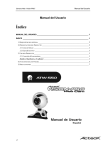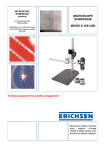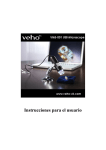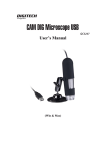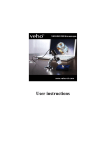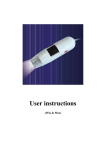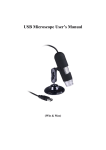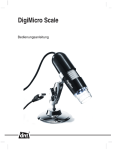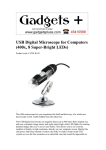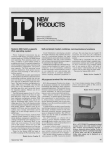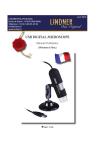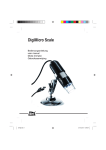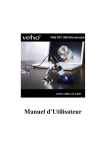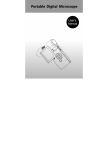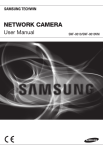Download USB Digital Microscope (20x-200x) User instructions
Transcript
User instructions USB Digital Microscope (20x-200x) Contents 1. Introduction 1.1 Computer System Requirements: 1.2 Technical Specifications 2. Install the software 3. A Quick Look at the Digital Microscope 3.1 Focus wheel 3.2 Snapshot button 3.3 LED light control wheel 4. Start Microscope 5. Options 5.1 Language 5.2 Change preview size 5.3 Rotate the output image angle 5.4 Date/ Time 5.5 Skin 5.6 Full screen 6. Capture 6.1 Photo capture 6.2 Video capture 6.2.1 Stop capture 7. Edit photos 7.1 Preview photos 7.2 Edit photos 7.3 Save photos 7.4 Delete photos 7.5 Copy photos 24 8. Videos 9. Quit MicroCapture 10. How to use measurement & calibration function 10.1 Direct-line 10.2 Multi-line 10.3 Circle-line 10.4 Circle-diameter 10.5 Angle 10.6 Unit 10.7 Notes 10.8 Font 10.9 Draw line 10.10 Line colour 10.11 Line thickness 10.12 Line type 10.13 Undo operation 11. Apple/ Mac-Software 11.1 Install the Software 11.2 How to use the Software 11.3 Quit Microcapture 12. Safety 25 User instructions 1.) Introduction Thank you for choosing our product - it is a high-tech yet easy to use Digital Microscope. With this unit you will see a unique and “bigger” world. It’s easy to zoom in on stamps, coins, paper currency, plants, insects, rocks and minerals, and so much more. We recommend reading this manual first to get the most out of this unit. 1.1 Computer System Requirements: • Windows 2000/XP/VISTA/WIN7 & Mac • P4 1,8 or above • RAM: 256M • Video Memory: 32M • USB-port: 2,0 • CD-ROM Drive 26 1.2 Technical Specifications Image sensor Still capture resolution 2 Mega Pixels (interpolated to 5M) 2560x2048 (5M), 2000x1600, 1600x1280 (2M), 1280x1024, 1024x960, 1024x768, 800x600, 640x480, 352x288, 320x240, 160x120 Video capture resolution 2560x2048 (5M), 2000x1600, 1600x1280 (2M), 1280x1024, 1024x960, 1024x768, 800x600, 640x480, 352x288, 320x240, 160x120 Focus Range Manual focus from 10mm to 500mm Frame Rate Max 30f/s under 600 Lus Brightness Magnification Ratio 20x to 200x Video format AVI Photo format JPEG or BMP Light source 8 LED (adjustable by control wheel) PC interface USB 2.0 Power source 5V DC from USB port OSD language English, German, Spanish, Korean, French, Russian Bundle software MicroCapture with measurement & calibration function Size 110mm (L) x 33mm (R) 27 2.) Install the software Connecting the Microscope to your Computer!! You must connect the Microscope to Computer before software installation. Insert the driver CD into CD-ROM Drive and this will automatically display the following interface: a) Install the driver by clicking “install Microscope Driver“. The Install Shield Wizard will walk you through the whole process. Click on the “Next” button to continue. b) Install the MicroCapture software Click MicroCapture software and then reboot the system when asked. c) You can also browse the User’s manual in PDF format and the CD contents by choosing the corresponding menus. 28 3.) 3.1 A Quick Look at the Digital Microscope Use the focus wheel to adjust focus of the microscope on the subject. The microscope is able to enlarge the subject to two different enlargements levels. To enlarge the subject to the next level, just continue turning the focus wheel. 3.2 The SNAPSHOT BUTTON enables the user to capture snapshots by hardware; photo capture by software is discussed later on in this manual. 3.3 The Light control wheel enables you to adjust the LED light brightness 29 4.) Start Microscope Connect your Microscope to your PC USB port, start the software by clicking the icon generated on the desktop after installation and you will see the following screen pop up: When the Microscope is disconnected from your PC USB port, the screen will display “No Device detected, please connect your Microscope directly to your PC USB port.” 30 5.) 5.1 Options Language You can choose the On Screen Display language by the following operation: 5.2 Change preview size You can change the preview size by the following operation: Note: The size of the photo taken is equivalent to the preview size selected in the Options menu/Preview Size. 31 5.3 Rotate the output image angle You can rotate the output image clockwise and counter-clockwise. 5.4 Date/Time You can display or turn off Date/Time by the following operation: 32 5.5 Skin You can choose to change the appearance of your MicroCapture screen by the following operation: 5.6 Full screen You can enter & quit full screen mode by: a) Double-clicking the preview area. b) Clicking the full screen icon: c) Choose Full screen mode from menu. When in full screen mode, click on the Full screen icon to turn off and restore toolbars and menus. 33 6.) Capture 6.1 Photo capture You can take photos in either of the following ways: a) Click the camera button b) Choose Capture and then click Photo c) By pressing F11 Captured photos are saved automatically and image thumbnails will be available on the right side of the MicroCapture screen for further editing. For editing photo, please refer to later operations. 6.2 Video capture You can record video by either of the following two ways: a) Click the video camera button b) Choose from the menu bar Capture and then click Video When recording, there is a red dot flashing on the video camera button. Video is saved in AVI format. 34 6.2.1 Stop capture: a) Click the flashing video camera button b) Choose Capture and then click Stop capturing Note: Please note the best pixel setting for video capturing is 640x480. 7.) 7.1 Edit photos Preview photos An image in the preview bar can be viewed in the large window by placing the mouse pointer over it (without clicking). 7.2 Edit photos Doubleclick the photo to open it in a separate preview window. For detailed instructions please refer to section 10. 35 7.3 Save photos You can save photo by right clicking on the thumbnail and then choose Save. The file can be saved in either jpeg or bmp. The jpeg size in which the photo is saved is the maximum allowed for jpeg. You can choose to decrease the size by adjusting quality. Click the Advanced button to view and select jpeg save options. 36 7.4 Delete photos By right clicking and then choosing Delete, you can delete the selected photo or, at the independent preview box, you can choose the delete icon to delete the previewed photo. 7.5 Copy photos Right click on the thumbnail and then choose Copy. 8.) Videos You can right click the video small icon listed on the right column and then choose Play, Copy, Delete, etc. 37 9.) Quit MicroCapture Tips: You can preset the preview window size, output image angle, language, etc, by editing an .ini file named ”Settings“ at C:\Programs\MicroCapture. 38 10.) How to use measurement & calibration function a) Point the microscope onto a target object e.g. a ruler; rotate the focus wheel to get a clear focus. b) When the focus is at the clearest point, take a snapshot c) Watch the calibration at the lower end of the focus wheel; note down the magnification value that corresponds to the indicator marker on the microscope body as shown below. That value is the magnification at which the focus was set and the image taken. (This is very important, since only with the magnification ratio noted down can the object size be worked out at later steps!!) indicator marker 39 d) Open the captured photo by double clicking on the thumbnail. A preview window will open: 31.00 e) Input the magnification ratio noted down into the box indicated at the top right corner of the preview window. (Please note it is necessary to input the magnification ratio noted down on step 3; otherwise the measurement is meaningless.) f) Now you can measure the size of the whole or part of the object you have taken using the available options. Click on the icons on top of the window. Choose from the following options: 10.1 Direct line: click , left-click mouse to choose a start point and drag mouse to an end point, Notice that the measurement is displayed. Release the mouse when done. 40 10.2 Multi-line: click , left-click mouse to choose a start point and drag to an end point. Notice that the measurements are displayed as you go along. Release mouse when done. You can continue measuring from the previous end point to a next point and so on. 10.3 , left-click to choose a start point for a circle; draw the circle to an Circle-radius: click end point, release the mouse, and the radius of the circle will be displayed. 10.4 Circle-diameter: click , left-clicking to choose a start point for a circle; draw the circle to an end point, release the mouse, and the radius of the circle will be displayed. 41 10.5 Angle: click , left-click to choose a start point for an angle, draw the line to another point and then release the mouse to create one line for an angle. Move your mouse to bring out another line of the angle and left-click when the angle is ok. The angle value will then be displayed. 10.6 Unit: click , you can choose the unit at which the measured values display. Units available include: pixels / inches / km / mt / mm / cm / micro. Other operations you can carry out on the photo taken include: 10.7 make notes on the photo taken 10.8 10.9 select font, font style, font size etc draw line, box etc on the photo 10.10 line color 10.11 line thickness 10.12 10.13 line type undo operation Note: The magnification ratio you are allowed to input is from 20 to 200. Do not input any value beyond that. The measurement value depends on: a) the taken, right measureing factor of the scale b) the exact position of the starting and endpoint The measurement function is only available on Windows Operating System. 42 11.) Instructions for Mac software 11.1 How to Install the Software Open mac folder from the disc and copy MicroCapture onto your desktop for daily use. 11.2 How to use MicroCapture Plug your Microscope into PC USB port. Double click MicroCapture icon to open the MicroCapture window. The microscope is now ready to use. For detailed information please move to chapter 5.-6. Please note that the measurement and calibration function is not available at a Mac. 43 11.3 Quit MicroCapture Choose Quit MicroCapture as follows, you can quit the software. 12.) Safety: The Microscope is not waterproof, so keep it dry. • Do not use it in a humid place like bathrooms. A dry environment will maintain its life to maximum. • Use the Microscope only at -5 °C -50 °C • Sudden temperature change may form dew inside the Microscope like entering a warm room in cold winter. Put it inside a handbag or plastic bag to slow down temperature changes. • Do not point Microscope lens to the sun or strong light for a long time. Powerful light may hurt the light-sensitive electronics. • Avoid touching the lens. • The white LEDs which illuminate the Microscope target field are very bright. Do not stare directly into these LEDs as it may damage your eyes. • The clear plastic distance shell sometimes picks up dirt or toxic material from a microscopically observed surface. Be careful that this doesn’t get in contact with the human skin. Always wash carefully or disinfect as needed. • Do not unplug the Microscope from USB port when LEDs are on. This may cause information loss or circuit damage. Please always close MicroCapture and then unplug the Microscope. 44






















